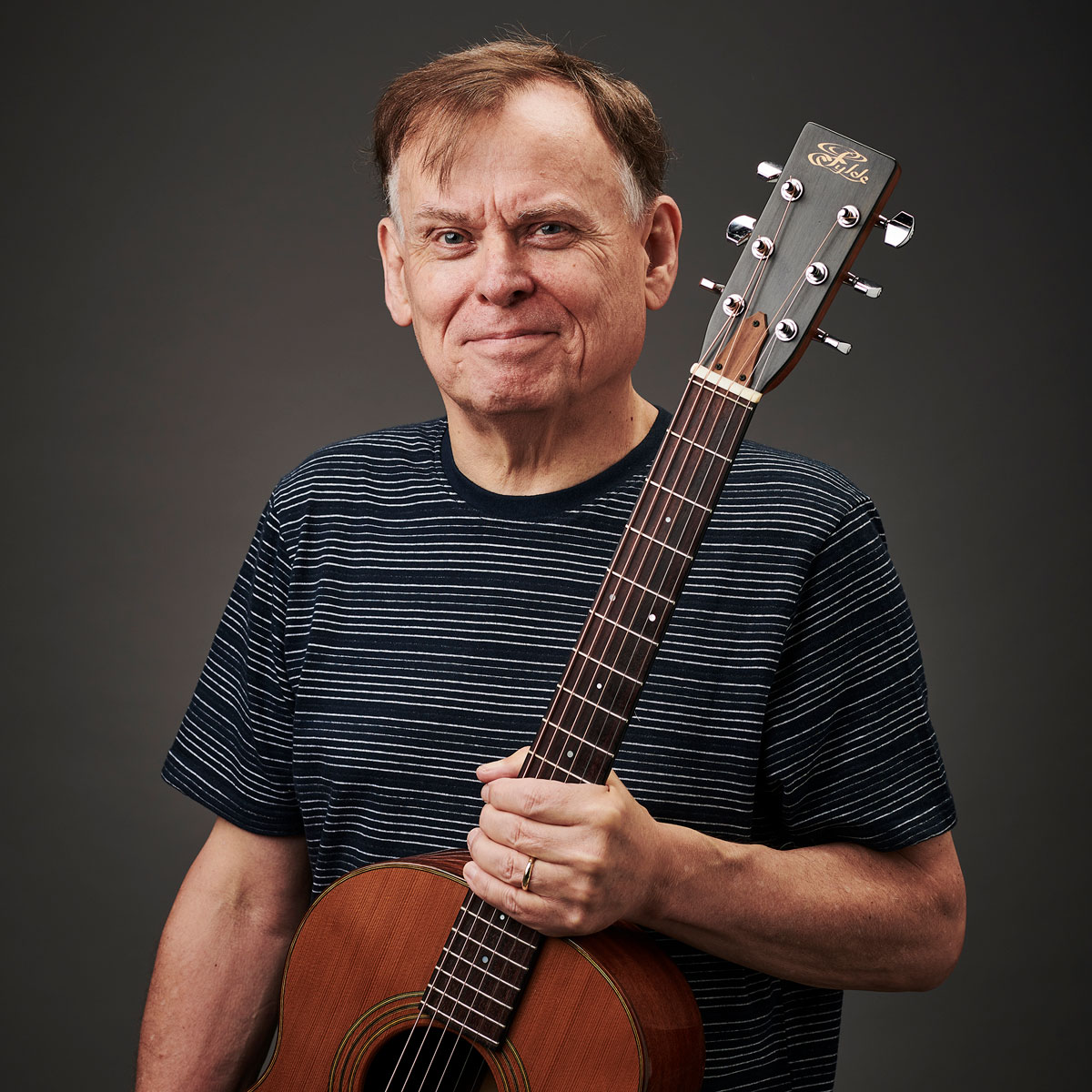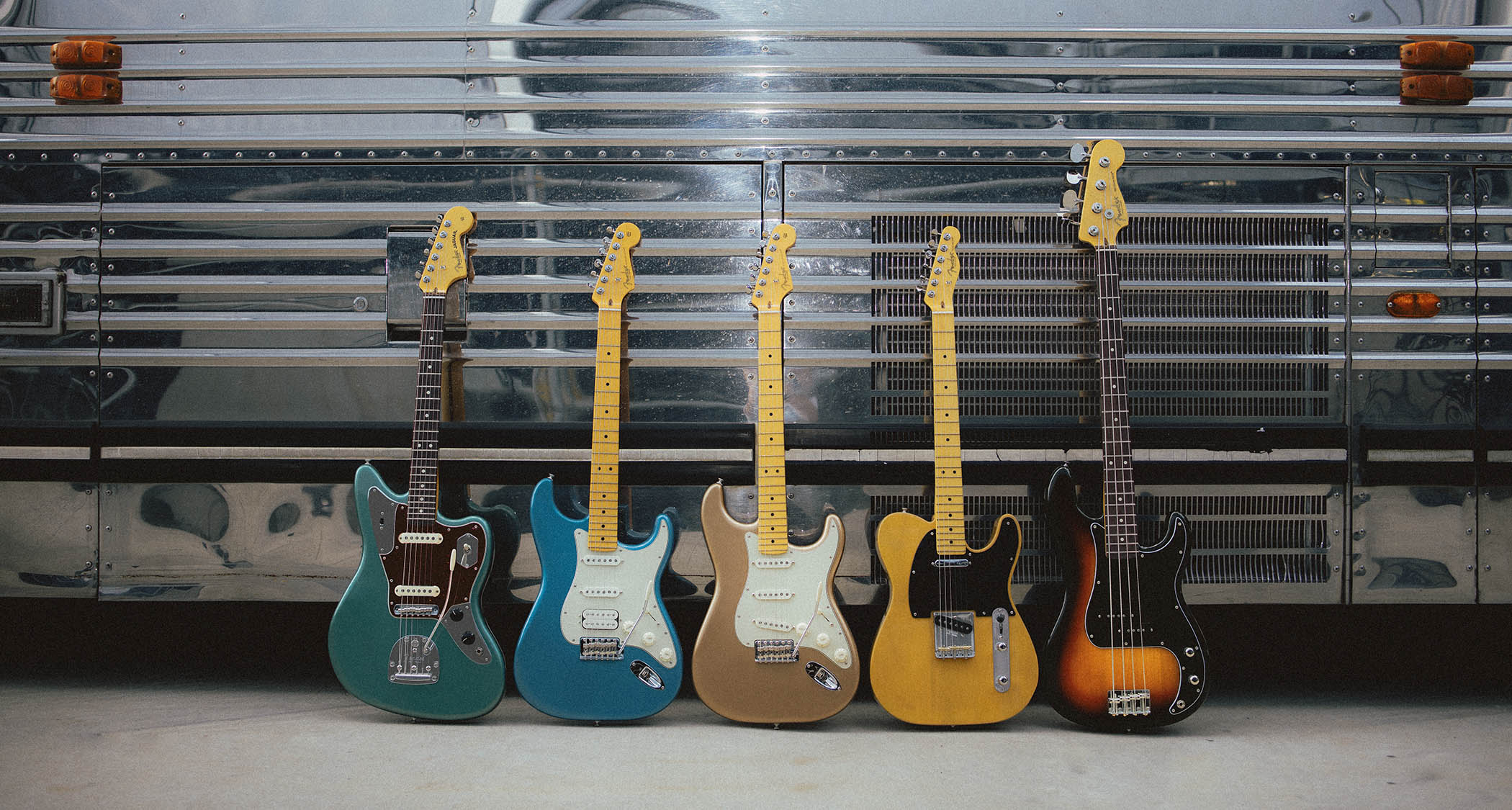“Everything is set as loud as it can go without collapsing. All my heroes played loud – Clapton played loud, Jimi Hendrix played loud”: Joe Bonamassa breaks down his epic onstage guitar rig – and why your volume control is a tonal superpower
Amid the mayhem of his European tour, Joe gives us a guided tour around his 2025 live gear and tells us why his mighty multi-amp rig has to be run at breaking point. All in the name of tone
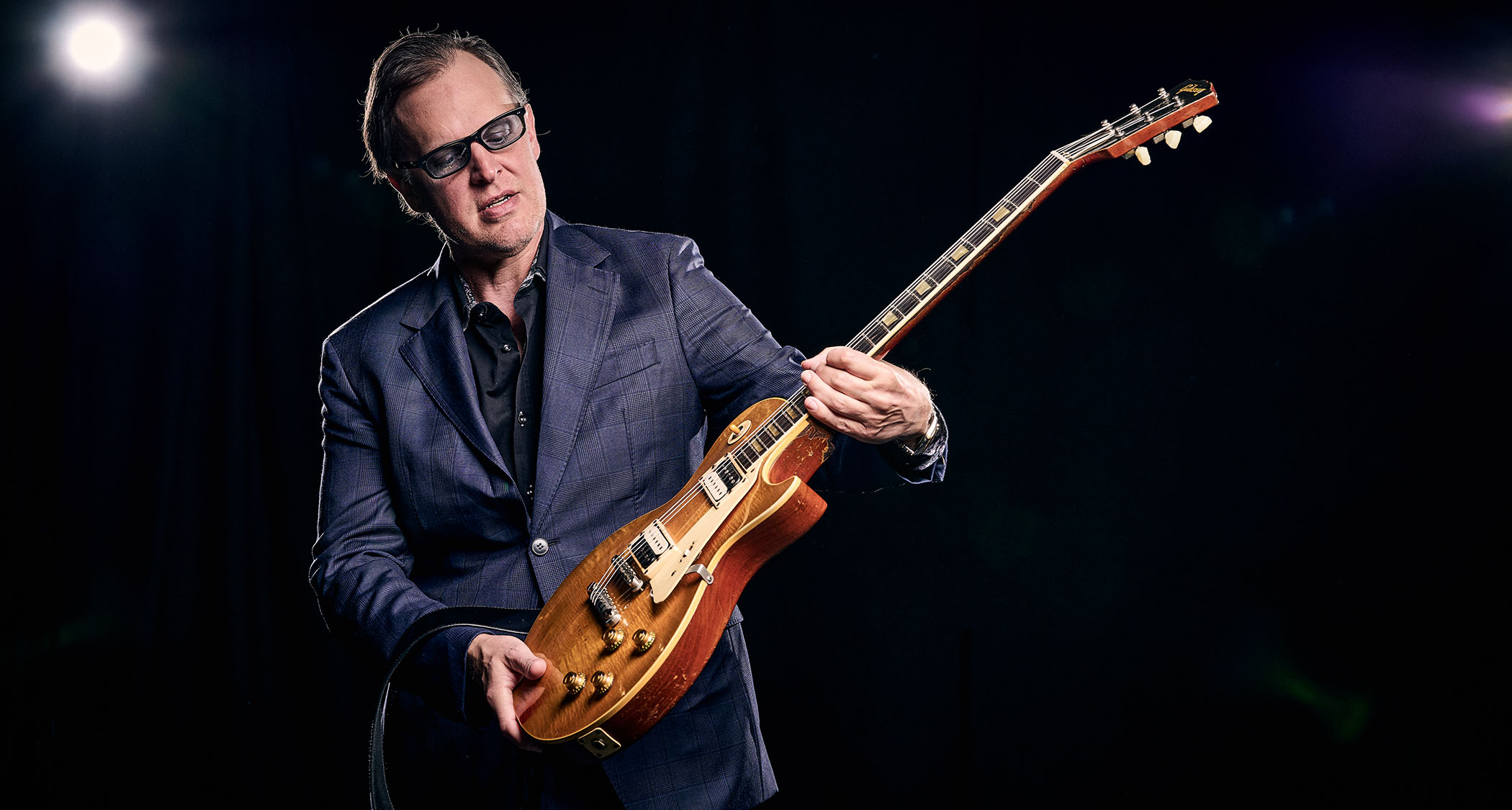
Let’s face it, this year didn’t exactly get off to a good start for Joe Bonamassa. For the first time, his renowned collection of guitars and amps at his LA home, known as Nerdville West, was under threat via circumstances that were raging completely out of his control.
January’s wildfires in California came way too close for comfort, and suddenly the whimsical question that we’ve asked many players in these pages regarding which instrument they’d save from a burning building became not only personal but horrifically real.
“I mean, I got evacuated and a lot of stuff had to be moved around,” he tells us. “It’s something I’d care not to go through again, but a lot of people lost everything, so I consider I’m one of the lucky ones.”
At the time, Joe posted on social media a film of him standing by a fully laden van, saying that he’d done all he could while preparing to drive some of his more irreplaceable instruments and amps to safety.
“A friend and I were able to get all the big stuff out,” he continues. “The Flying Vs, there were nine sunburst Les Pauls at the house at that time, a fancy Martin, the Broadcaster… all the big stuff went. We only had one shot and it was like, I think, 55 guitars and a Dumble and a Trainwreck.
“My manager [Roy Weisman] was there a couple of weeks later for the Grammys, and he was at my house. He’s like, ‘Wow, you really did a good job putting everything back after you were evacuated.’ I said, ‘Roy, this is what I left behind.’ I mean, I have 400 guitars there and probably 300 amps; there was just no way I could take all of it. It would take a week to move it.”
Moving forward to happier times, we encountered Joe three times on the recent tour, in Cardiff, Liverpool and Antwerp, Belgium, where we were introduced to both the intricacy of his current touring rig – “It’s not complicated, it’s just vast…” – and some of the guitars that play a role in the current setlist.
All the latest guitar news, interviews, lessons, reviews, deals and more, direct to your inbox!
Meanwhile, there’s a new album waiting in the wings; Breakthrough will be released this July and Joe offers some insight into the instruments that accompanied him to the studio. So buckle up, gearheads, you’re in for a treat.
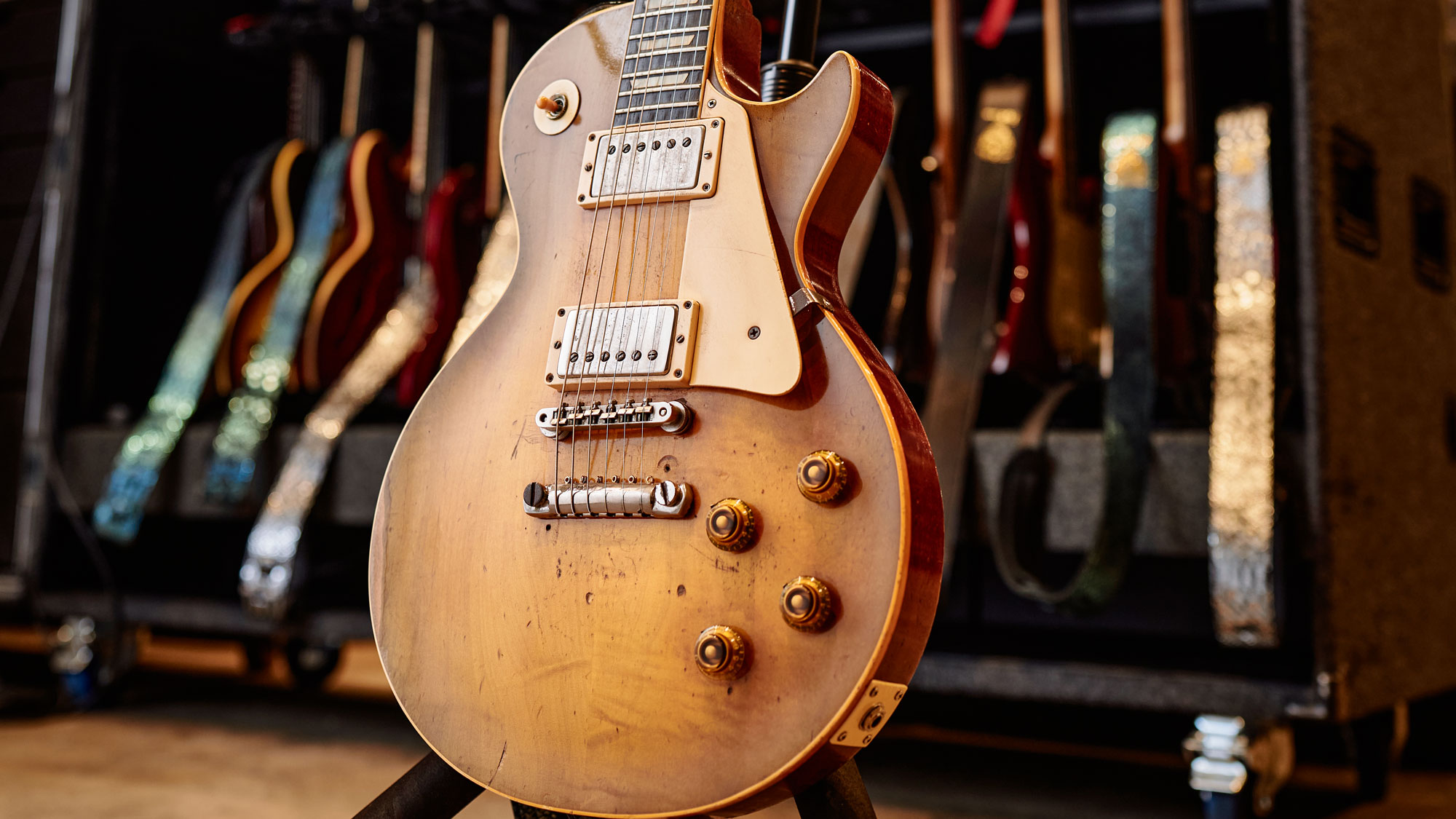
Selecting some guitars from the rack, first off is a Les Paul with a nice faded sunburst…
“That’s the ‘Snake Bite’. I’ve had it for a long time. It’s a ’59 Standard. A guy in North Carolina bought it in a pawn shop for $700 in 1985 and I got it from him for more than $700 but less than most. At the time, I think it was $120,000 or something like that. It’s one of my favourite road guitars. I love that guitar. I mean, it’s beautifully worn in and it’s obviously not mint, but it’s a great Les Paul.”
Next in line is a Gibson ES-335 with a Bigsby.
“That’s a ’63. Nice guitar. I’ve owned that for years. I have two rigs, you know? There are two versions of all this. I needed a 335 with a Bigsby and so this one just hit the mark nicely. I think it’s one of the last [335s] with two Patent Applied For pickups, which is rare to see for early ’63, but they do exist. I use it for Dust Bowl and for Driving Towards The Daylight. One’s a capo on the 5th fret and one’s a capo on the 1st fret.”
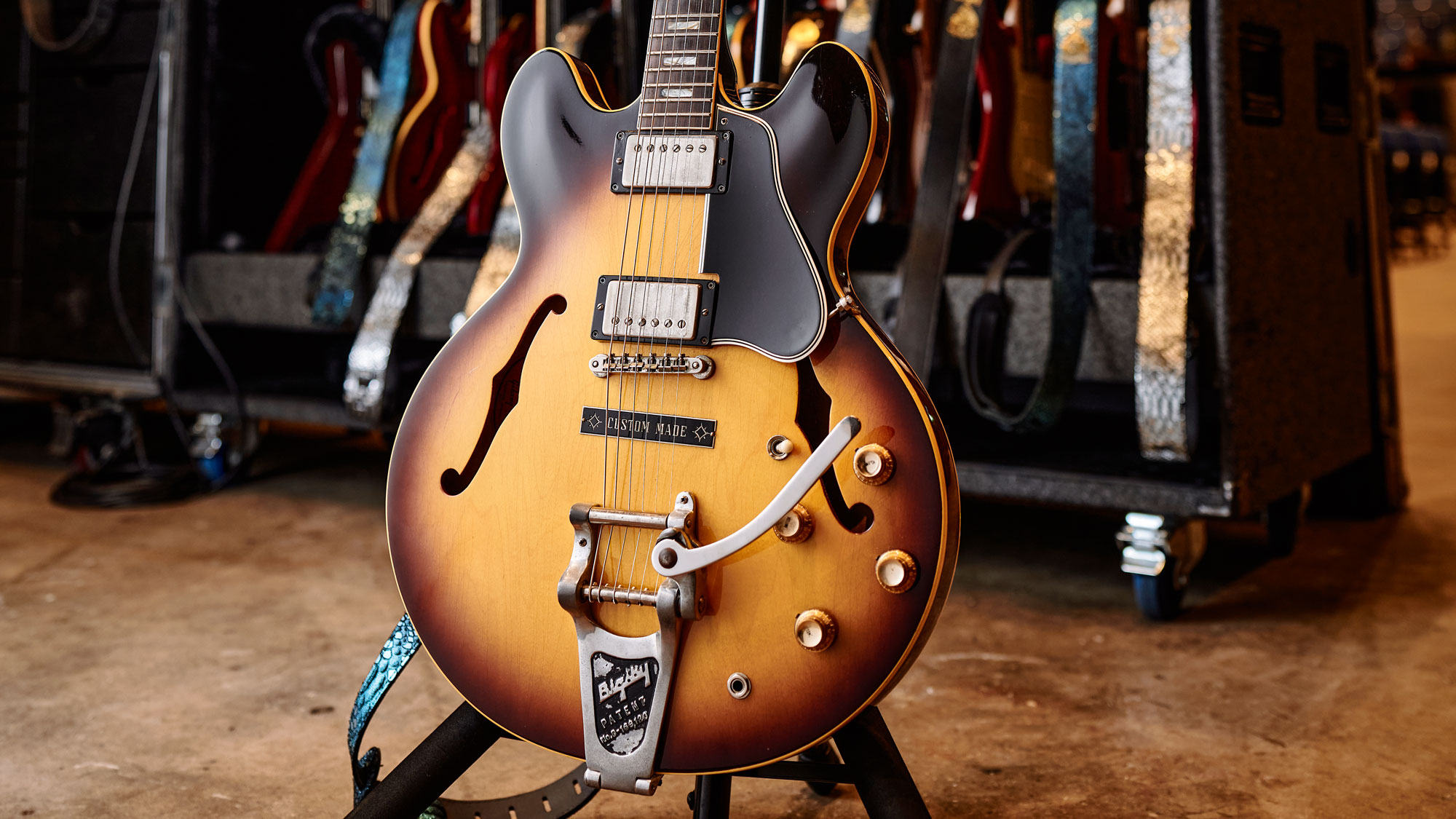
There’s a Les Paul with a little switch on the pickguard…
“That’s the ‘Royal Albert’. That’s the one that Mike Long from ATB Guitars found – it was under a staircase for 50 years. The story was that the [original owner] saw Cream in 1967, wanted a Les Paul and he found one for sale in the classified section of Melody Maker and bought it for about £50. [After he died] his family brought it to Mike, thinking it could be worth as much as £5,000.
“He was the one to tell them that, ‘No, it’s actually worth more than that…’ It’s an early 1960, what they call a ‘double-O’ because it still has the fat neck and the long neck tenon, like a ’59, but they were made in 1960 and, generally, in that era you see double whites and zebras [pickup bobbins]. So it makes sense.”
The switch would have been too early for a coil-tap – do you know what it was?
“It was probably a phase switch because they ran the wires through the pickup ring into the channel route and then to a volume pot. So it was probably just a phase. I don’t think they knew what [a coil-tap] was back then. But it’s the original pickguard, and that switch has been on there for a long time. You can tell that.”

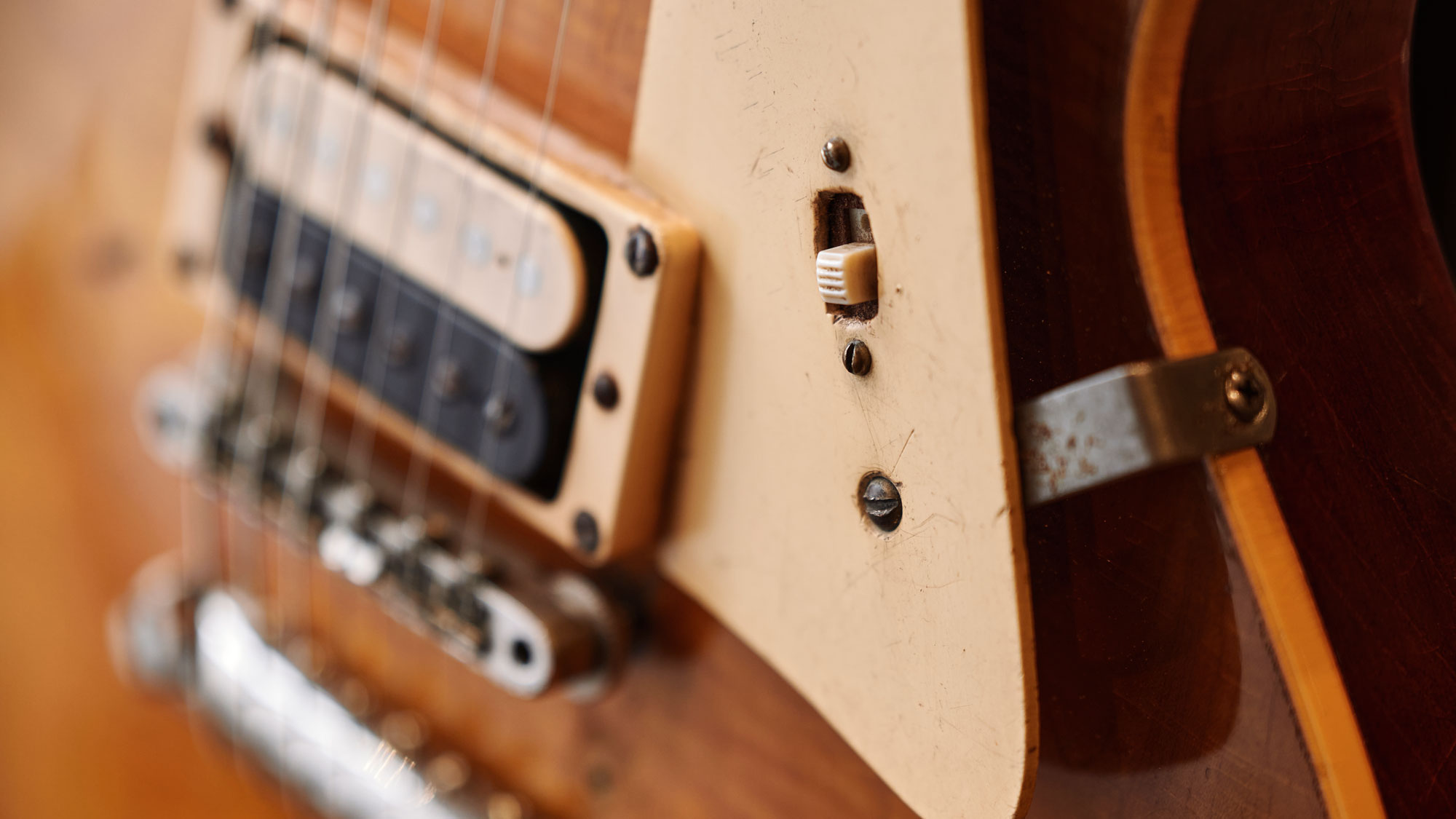
Tell us about ‘Bonnie’, the 1955 Stratocaster.
“I’ve had that guitar for years; I’ve probably done 1,200 gigs with it. Up until 2018 it didn’t have a name, it was just my number one road Strat. I love it. It’s a hardtail and I got it from Trevor Boone at Emerald City Guitars years and years ago.
“It’s called ‘Bonnie’ now because when Bonnie Bramlett – the legend – sang on Reese Wynans’ record that I produced [Sweet Release, 2019], she brought her guitar that she had had everybody from Jerry Garcia to Kris Kristofferson carve their name on with a knife over the years. And she wanted me to carve my name on it.
“At first I was like, ‘Bonnie, I don’t deserve to be on here.’ But she insisted. And I have a rule: I never argue with a Rock And Roll Hall Of Fame member and a woman holding a knife. So I’m like, ‘All right, Bonnie, I’ll bite…’
“So when she came in a few months later – she came and sang with us in St Louis – I said, ‘Bring your Dremel. I want you to sign a guitar.’ So I just picked that guitar and she Dremel’d her name in the back of it, so it’s forever known as the ‘Bonnie’ Strat.”
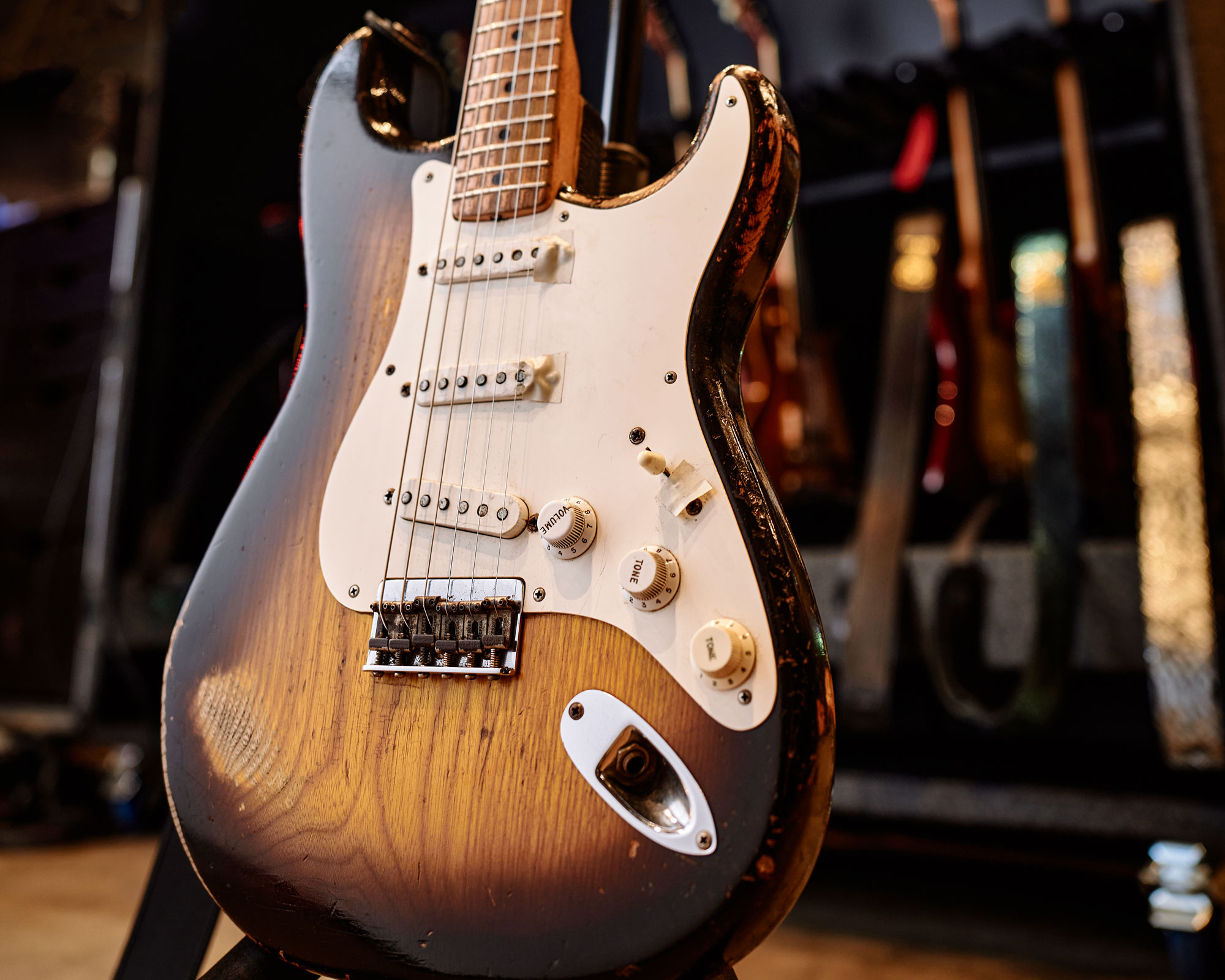
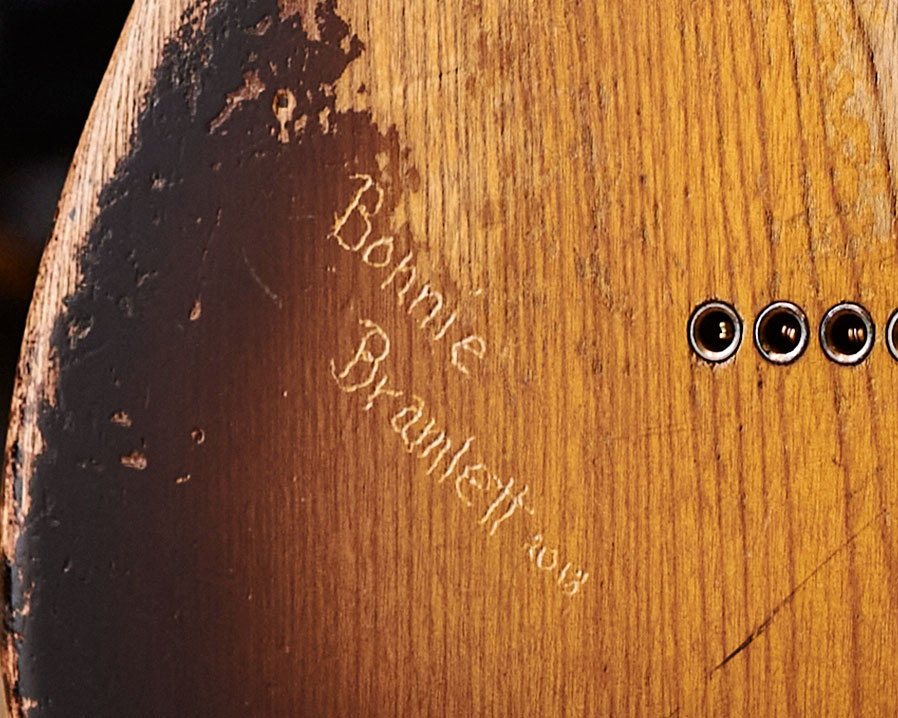
The purple Telecaster with the Fender full-range humbucker on it looks interesting. It looks like somebody has tried to respray it Burgundy Mist?
“It’s purple. Somebody painted over the original blonde and it’s a maple cap neck. It’s a ’68 and they put a Seth Lover Fender humbucker in it. Seth Lover designed that pickup for Fender; he switched teams and went over to Fender. Those kinds of things are right up my alley.
“I love those guitars. Are they honest? You know, people modded like that back in the day because they thought the guitars weren’t worth anything, you know? And they just wanted the humbucker, and they wanted it purple.
“So they came up with some sort of Burgundy Mist. That paint’s been on there for 50 years, and that pickup has been in there for just about as long. It’s a great road guitar, and I use it on the last song [in the set].”
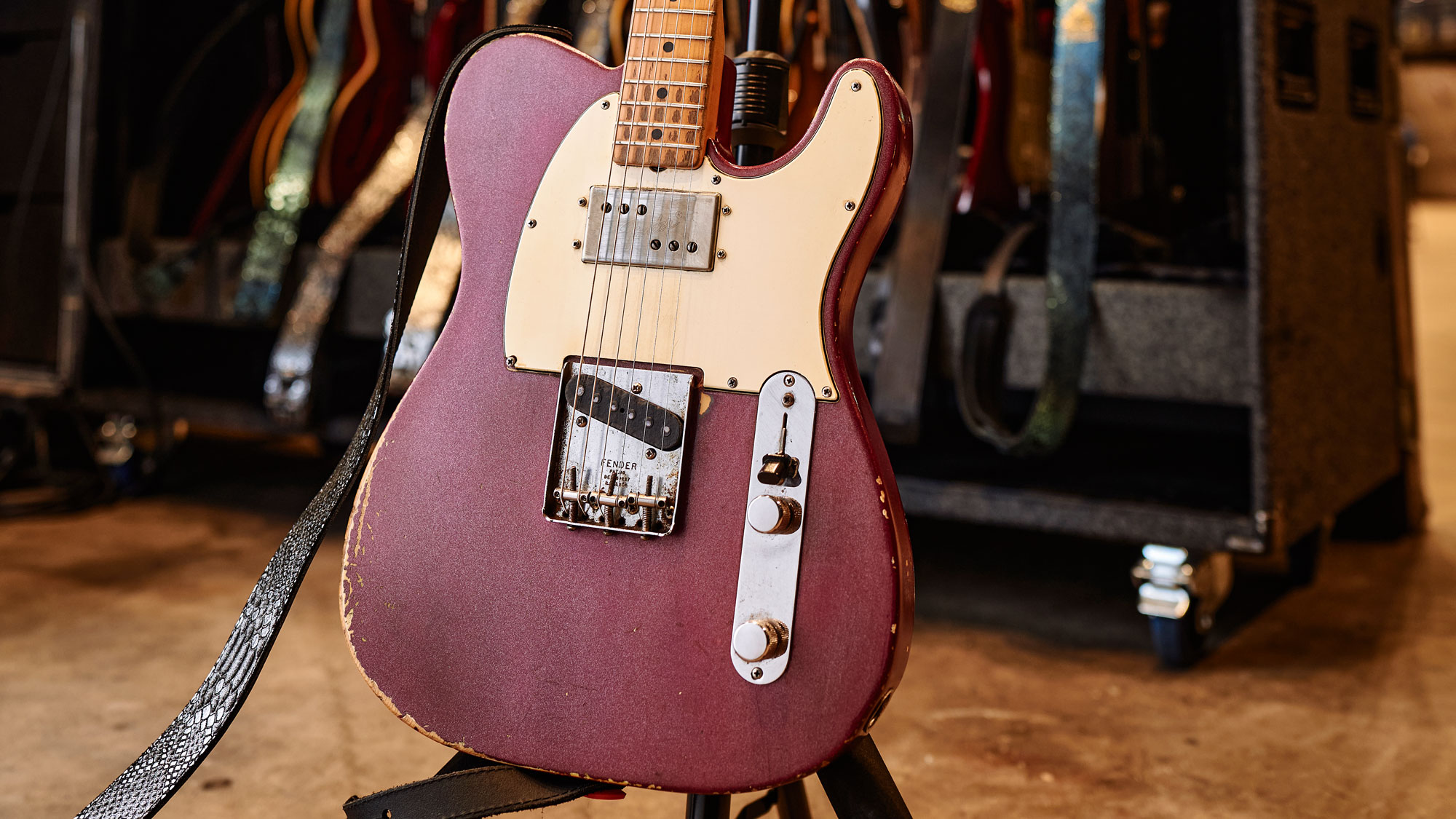
You have another Telecaster, too, and this one looks more original. What’s the story there?
“Yeah, that’s a ’53 Blackguard. I bought that guitar in 2008 after I turned a decent profit on a tour. It was the first time I made what I thought was real money and I treated myself. I bought it from Buzzy Levine at Lark Street Music because I thought it looked like Danny Gatton’s guitar.
“I stared at that guitar on Buzzy’s website for months and months and months and I finally bought it. I usually use it on Mountain Time and for The Heart That Never Waits. It weighs, like, six-and-a-half pounds. Really, super light. It’s one of the lightest Blackguards I’ve ever felt.”
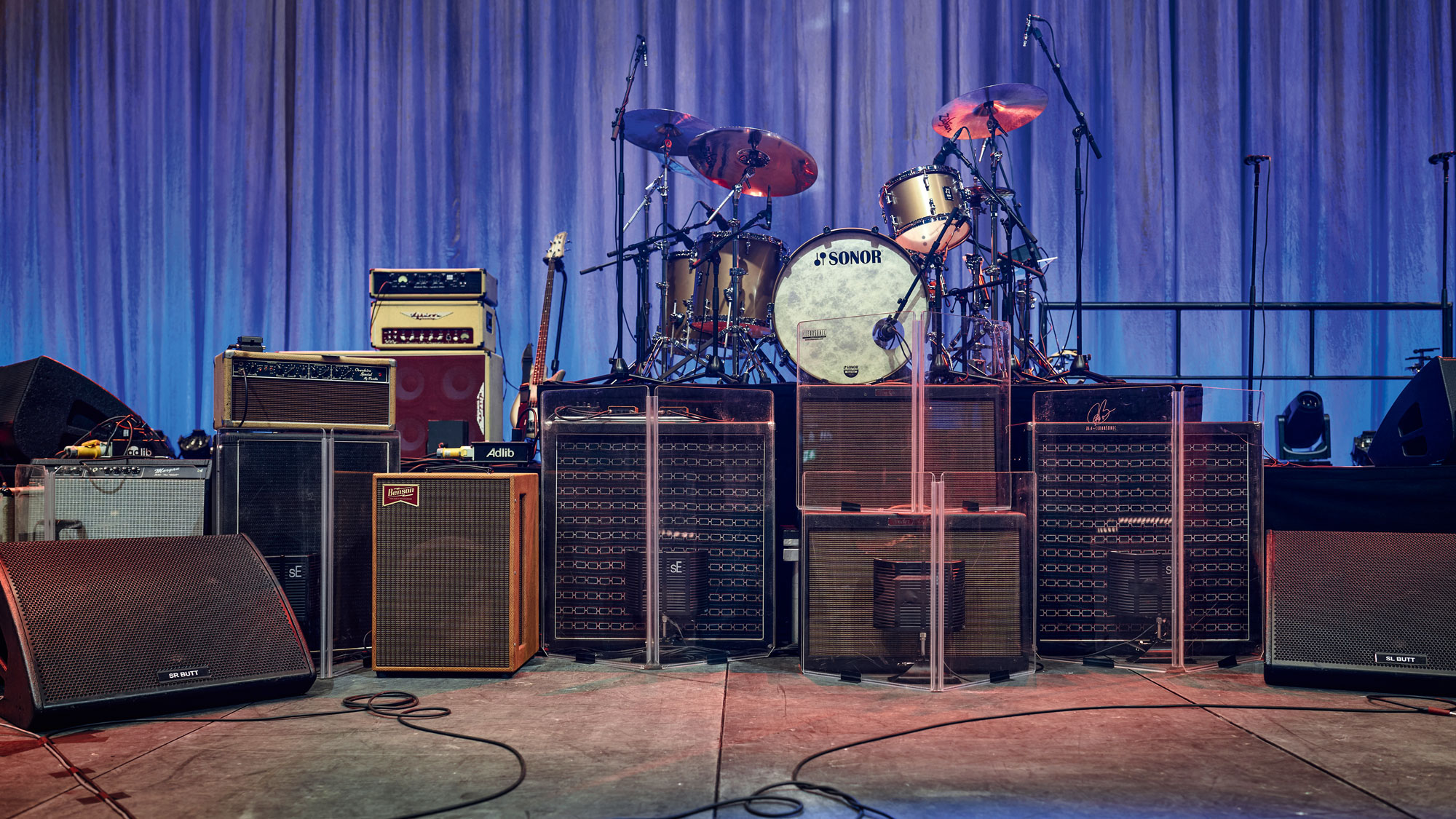
Looking at your stage rig, what model is the Dumble amp on the far left?
“That’s an Overdrive Special from 1983 that I bought from the original owner; he paid $3,000 in ’83 and he sold it to me for significantly more. The cabinet is a ’90s Dumble 2x12 with Electro-Voice 12L speakers. That’s next to a Leslie speaker [marked Benson] – that’s a rotating speaker but with a 12[-inch speaker] instead of a 10, right?”
The two 4x12 cabinets towards the centre of the backline look like they have the old 1960s WEM (Watkins Electric Music) speaker cloth in them.
“Yeah, those cabinets were built by Peter Van Weelden in 2006 and that’s original WEM grille cloth that he found – like New Old Stock – and those have four EV 12Ls in them. Both cabinets are Electro-Voice. The two Fender amps in the middle are Joe Bonamassa High Powered Tweed Twins, only Fender built me black cases for them so it matches the rig.
“It looks nicer and they do actually sound different. With the black Tolex versus the tweed, they’re actually a little brighter and more open, believe it or not. It does affect the sound.”
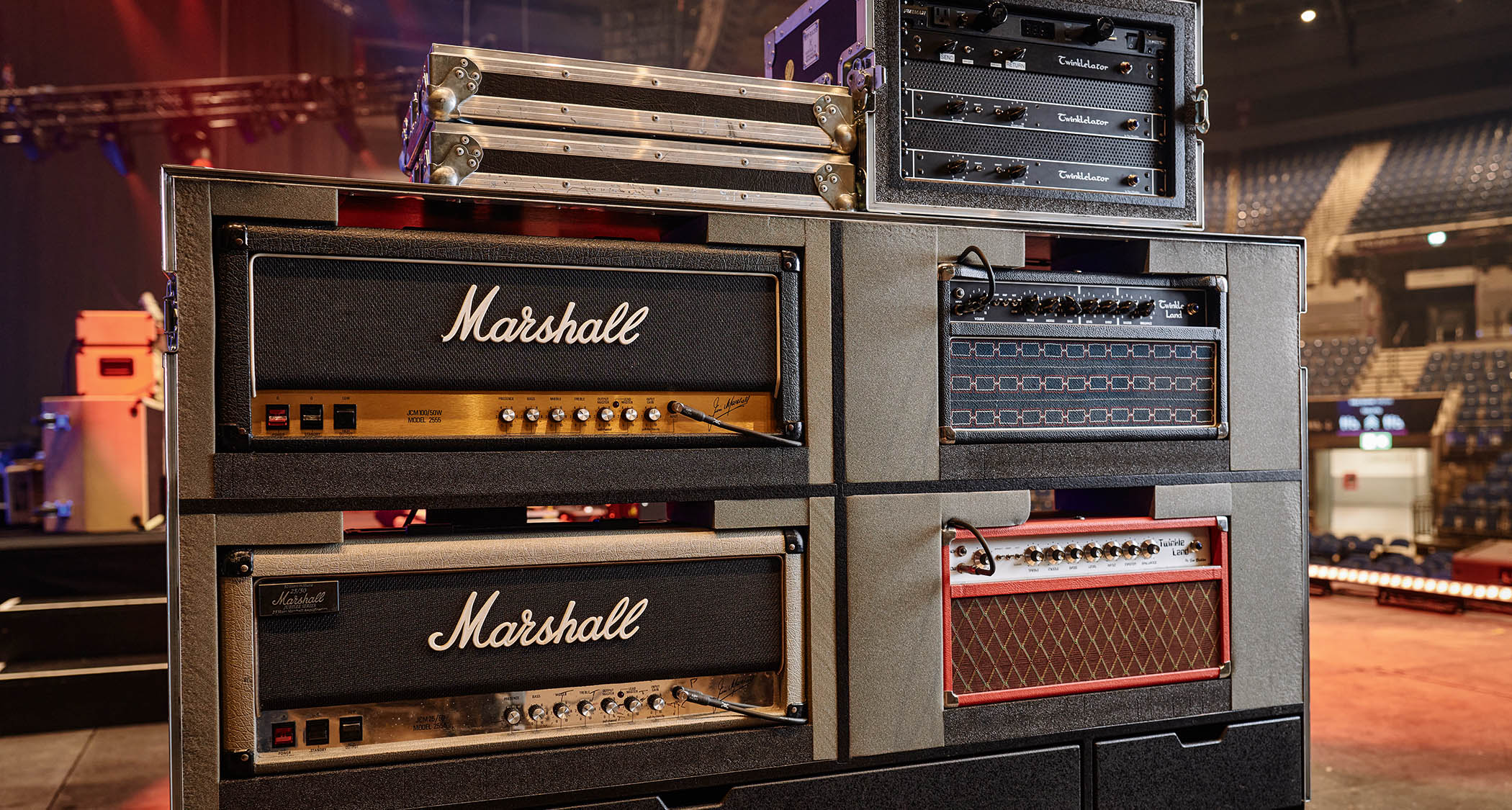
Moving over to the side of the stage, there are some more amps. Can you talk us through them?
“Sure. On the left there are two Marshall heads: one’s a 1987 Silver Jubilee and one’s a 1988 2555, both 100 watts. They’re the exact same amp – one’s obviously silver one, one’s a black one – and they’re always on.
“And then I have a [Lehle] switcher on the pedalboard: setting A is the two Marshalls and the two Twins; setting B is the two Marshalls and the two Van Weelden Twinkle Lands, which are basically Overdrive Special copies, and that’s basically both cabinets running at the same time; setting C is the two Marshalls and the Overdrive Special. So they’re not all on at the same time. Generally, it’s four on at the same time, sometimes three.”
Why did you go for a separate rack for the off-stage amps?
“The reason why I racked the amp heads is I found out, when we put the original amp shanty together, that the amps are way more reliable because they’re riding in shockproof cases, right? They’re not getting bumped around as much as they would if we had to pull them out of cases, stack them up on cabinets, pull them back down.
“It just simplifies the wiring and makes reliability much better. It’s important to note that I’m crazy enough that there’s two of them, the amp shanties, and a whole different rack of guitars. So we’re just talking about the stuff that’s on tour now in Europe.
“This is the European one for this year, and everything comes back at the end of the year to Nashville. Normally, we have to leapfrog rigs and so I have two sets of guitars, two sets of amps, two sets of everything.”
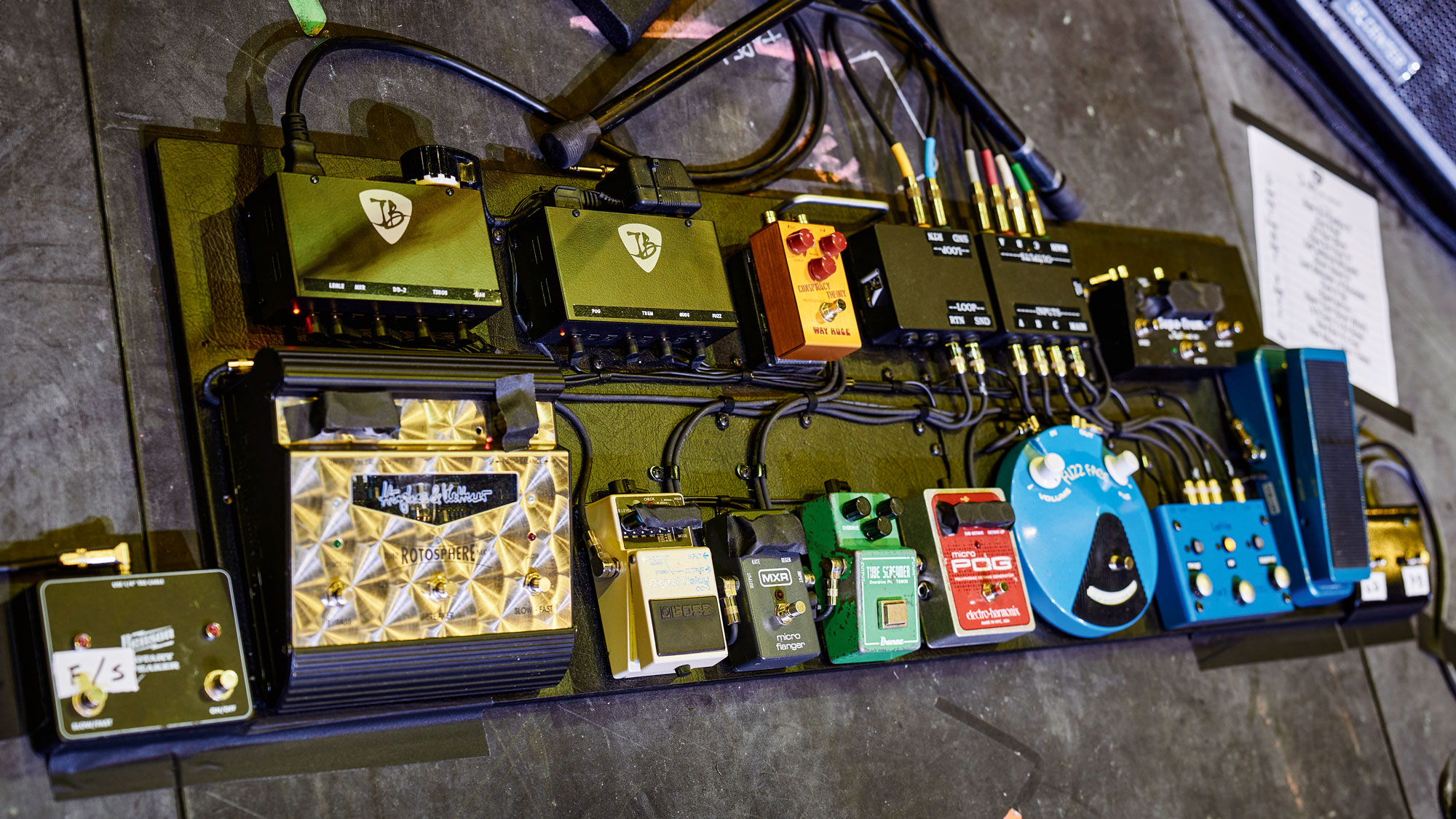
Looking at your pedalboard now, the switch at the far left looks like it could be the controller for your rotary speaker?
“Yeah, that’s the on/off and the fast/slow speeds for the rotary cabinet. Then there’s the Hughes & Kettner Rotosphere, which is the fake Leslie – that goes through the Marshalls. Then there’s a Boss DD-2. The Hughes & Kettner and the Boss both go through the effects loop of the Marshall.”
Then we’ve got an MXR Micro Flanger pedal. Have any of the effects been modified or tweaked in any way?
“Nope, standard issue – I buy them out of Sweetwater. There’s a Tube Screamer that is either an ’80 or an ’81. A Micro Pog and a Fuzz Face that goes through the Twins. Then the switcher and the wah and the Fulltone [Supa-]Trem and a Way Huge Conspiracy Theory.
“The rest of it’s just junction boxes, you know: inputs for the amps, and a junction box, basically, to get to the switcher and out, and then there’s the two boxes that power everything.”
Looking at your amp settings, it’s very much a case of everything on 11 in many ways.
Very rarely do I go full up on the guitar. I will go full up, and then back it down a number or two
“Everything is set as loud as it can go without collapsing, you know what I mean? I am not subtle at all and I do not subscribe to the ‘low volume sounds bigger’ method. I’ve got to move air.
“All my heroes played loud: Clapton played loud, Jimi Hendrix played loud. Everybody played loud at one point. There’s a symbiotic relationship between volume and the guitar.
“I generally don’t solo on 10 all night. Very rarely do I go full up on the guitar. I will go full up, and then back it down a number or two. And that little bit of capacitance from the pot really just makes it super-articulate and really fat. You get a little hump on the mids around 250Hz. They’re the original pots, which makes a huge difference, because the difference between modern pots and old pots is significant.”
CTS pots and Orange Drop capacitors have become something of a mantra for guitarists chasing vintage tone these days. What is the difference between old and new?
“Well, they may say CTS and they may look orange, but they’re not made to the same specs as they did in the ‘50s, and it’s no fault of any manufacturers – it’s just what’s available. The taper on a modern pot is so different from a taper on a vintage pot, you know? I mean, even pots from the ‘70s don’t taper the same way. You get good pots until about 1968 or 1969 and then things start going off the rails a little bit.
“I’m very blessed to use very nice, valuable old guitars as my daily drivers. I don’t look at them like museum pieces, they’re what I use. But if you spend enough time with them, you do notice a bunch of things when you play a modern guitar.
“You’re like, ‘Man, I know my volume’s down and between 0 and 2, but there’s nothing happening.’ Then when you hit 2 on the [volume control] the whole thing, it just jumps up. It’s not a complete taper from 10 down, you know what I mean?”
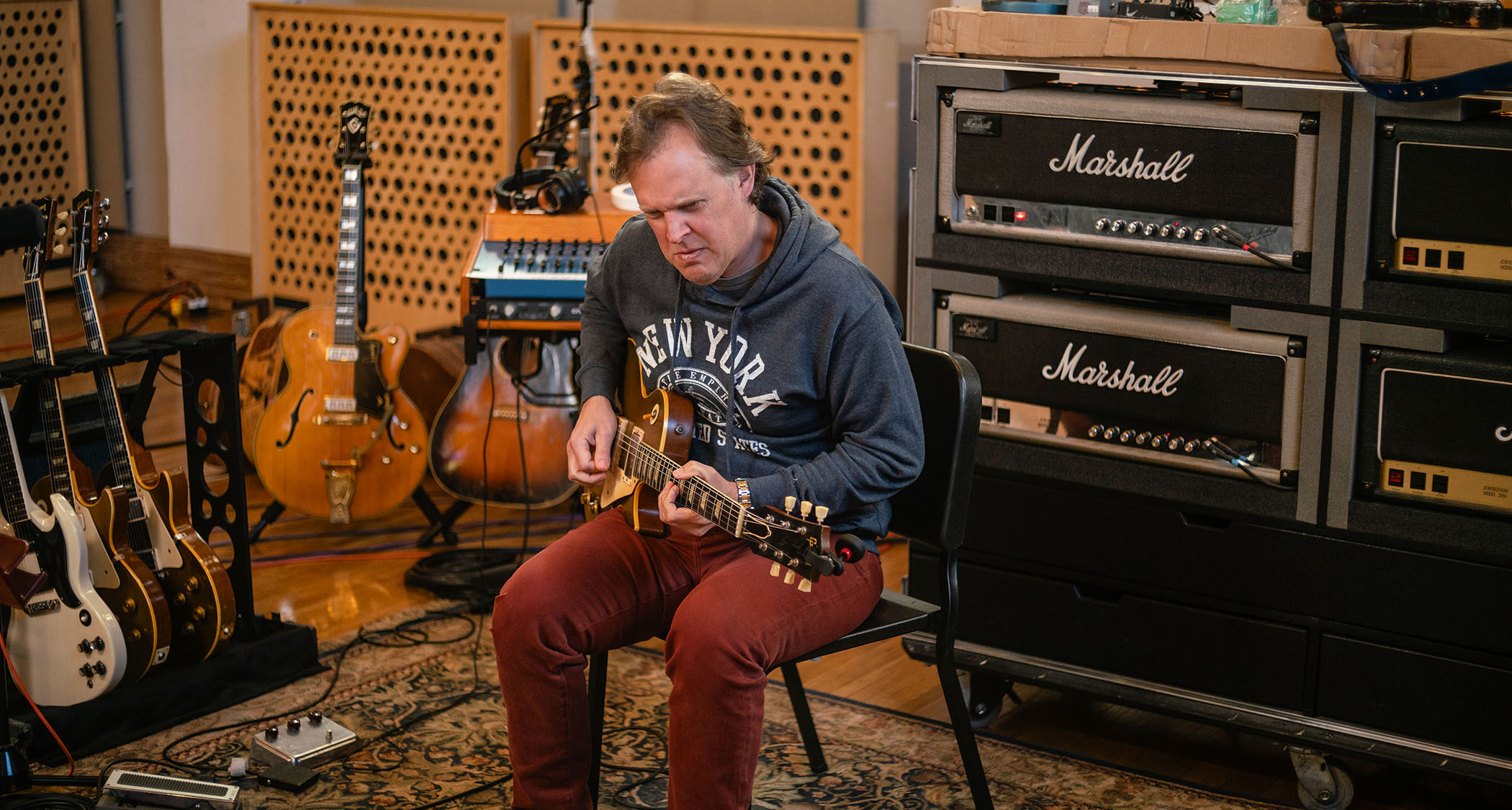
What do you take with you into the studio these days?
“I take less now than I used to. I take fewer guitars now, too. I use six guitars, maybe eight tops, in the studio. A couple of acoustics. I’ll bring a Brazilian rosewood Martin. I’ll bring a mahogany D-18 or a 000-18 and a 000-45 or a 00-42, something like that.
“Different colours, you know? Mahogany sounds different on a microphone than Brazilian. And then I’ll bring a rosewood-[’board] Strat, I’ll bring a maple-[’board] Strat, some facet of a Telecaster or two.
“I generally like maple necks on Teles because it just sounds the way I think a Tele should sound. I’ll bring a Les Paul Standard, a 335, maybe an SG, and then a baritone… and something with a Bigsby, like a Gretsch 6120, or something like that.”

The new album sounds like it has the occasional drop-tuning on it. Would that be the baritone guitar in action?
I mean, the tuning stays pretty solid down to about D, a full step down. If you have to go below that, I’d rather just capo a baritone
“Sometimes I just tune the guitar down a little bit. I mean, the tuning stays pretty solid down to about D, a full step down. If you have to go below that, I’d rather just capo a baritone.
“It’s just for tuning. Guitars tend to like to live in A440. That’s when I find them to be more solid, tuning-wise. Tuning down, sometimes you have to back the truss rod down slightly just to create tension on the neck that doesn’t exist in the strings.”
Being on the road so much, when do you actually get time to write new material?
“I write when I have to, you know? I get six weeks out from a record and I just start writing it. But this one we did over two years, so we wrote it in chunks and recorded it in different studios: we did some in Greece, we did some in Nashville, we did some in LA.”
As a renowned collector, have you been shopping on this trip?
“I have not bought an instrument. I bought an amp and a Klon – that’s the only two things that I got. I bought a really cool 1966 JTM45, one of the first 100-watters. I got it through a friend in the UK and I picked it up in Brighton.”
Only we noticed that ATB Guitars has an original 1959 Lifton Les Paul case that used to belong to Martin Barre…
“And I’ll give you one shot to guess who just paid £2,500 for that particular case. One guess…”
It wouldn’t be you, would it?
“Probably! [laughs] I’ve known Martin for 25 years and I still think that Martin’s sunburst Les Paul tone with Jethro Tull is, to me, one of the finest Gibson-through-a-Marshall rock guitar sounds that I’ve ever heard in my life. I mean, just a beautiful, rich, clear, nice bite but not too bright, distorted Marshall.
“When I think of a Les Paul through a Marshall, I think Clapton and the ‘Beano’ album, I think Billy Gibbons, I think Jimmy Page, I think the early Jeff Beck stuff. And I think Martin. So to have a little piece of Martin’s past is cool.”
- Breakthrough is available on 18 July via J&R Adventures
- This article first appeared in Guitarist. Subscribe and save
With over 30 years’ experience writing for guitar magazines, including at one time occupying the role of editor for Guitarist and Guitar Techniques, David is also the best-selling author of a number of guitar books for Sanctuary Publishing, Music Sales, Mel Bay and Hal Leonard. As a player he has performed with blues sax legend Dick Heckstall-Smith, played rock ’n’ roll in Marty Wilde’s band, duetted with Martin Taylor and taken part in charity gigs backing Gary Moore, Bernie Marsden and Robbie McIntosh, among others. An avid composer of acoustic guitar instrumentals, he has released two acclaimed albums, Nocturnal and Arboretum.
You must confirm your public display name before commenting
Please logout and then login again, you will then be prompted to enter your display name.


